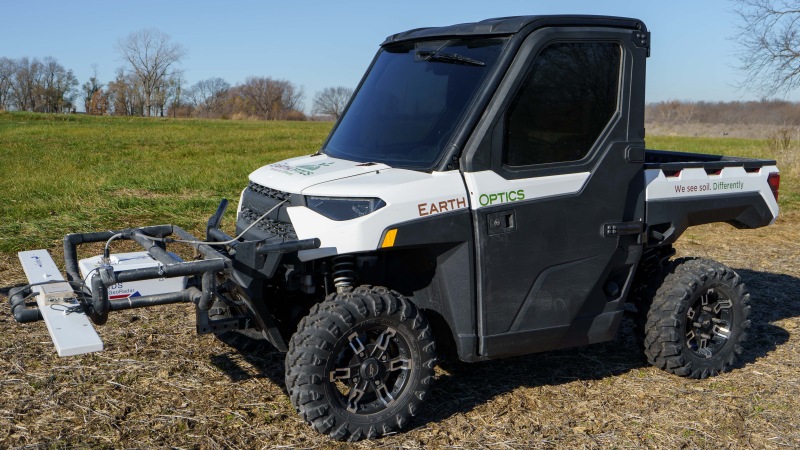Seed: A Real Treatment
When Josh Peters of Peters Crop Solutions, Aplington, IA, looks ahead, what does he see for the future of the seed industry and ag retailers? More pressure at the dealer level to treat seed faster and with more precision.
Several factors are driving the increased demand for treating seed from grower-customers, including a shifting spectrum of plant diseases and insects, new seed-applied crop protection products, volatile commodity markets, and last-minute crop planning, says Peters. An ever-increasing percentage of growers are pushing their cropping plans until the last minute, which is putting pressure on dealers to provide more on-demand seed treatment capabilities for their customers rather than pre-ordering treated seed from seed companies.
Instead of resisting the changes in the industry, though, Peters is meeting the challenges head-on and banking on new seed treatment equipment technology that is just now coming off the factory floor.
Primarily treating soybeans for clients, Peters has made the move to upgrade to a newer, more computerized seed treater to help keep ahead of what he describes as a rapidly changing industry.
While his older seed treater shouldered his business’s growing demands over the three years he’s offered on-demand seed treatment, Peters is anticipating the challenges ahead to require still more precision, speed, and volume.
“As new technology comes out, we foresee that we’ll be putting a lot of different chemicals on seed for different customers,” he says. “The flexibility of applying different chemicals is where we’ll have to build into eventually.”
Until a few years ago, Peters’ customer base didn’t regularly plant treated soybeans. Now a significant percentage treat soybean seed, and the trend is up.
“Now we’re seeing where everybody’s treating their seed,” says Peters, who upgraded to a new Gustafson RH-2000 machine for the upcoming 2010 season.
While that gradual shift to treating seed at the dealer level has created another revenue stream for Peters Crop Solutions, it has also been a great help in giving Peters’ grower-customers more flexibility in their planting decisions. The new seed treater, he says, provides computer print-outs that immediately show the grower the chemical that has been applied, as well as the rate.
Customer Flexibility
The idea of giving customers even more flexibility with seed treatment prompted Jeramy Slade, branch manager for Agriliance in Jonesville, LA, to also invest in a new seed treater.
Slade says that after making the move to invest in a new seed treatment machine in March 2009, the dealership has created a whole new revenue stream by adding another valuable service for customers that saves growers time during the planting season.
“There’s just a lot of profit dollars in treating seed yourself instead of going to the seed company and waiting for it to get back,” says Slade, who says cotton and soybeans are the most popular seeds treated at their location. Corn and wheat are also treated at the facility.
“In the past, you had to ship it to another location to get it treated,” he adds. “That took lots of time and fuel.”
By bringing the seed treatment activities closer to the grower at the dealer level, local growers now have the advantage of treating seed at a moment’s notice before heading into the field — giving them the luxury of time during a hectic planting season.
“Growers call me last minute before they head into the field and I’ll have their seed ready and treated before they get here,” Slade says.
Treating seed on-site opened the door to two avenues of profit for the dealership: One through the service itself and another through crop protection sales. Having a seed treater on-site also has the added benefit of fascinating customers, Slade says.
“A few [customers] come up and watch us treat the seed,” he says. “They seem pretty amazed with it.”
Slade, who treats seed with a Gustafson RH-24, has seen a noticeable trend in the industry of treating seed on-site rather than pre-ordering from seed companies as other businesses adopt newer technology to become more competitive.
Gustafson, one of the largest brands of seed treatment equipment, reports that sales among small- and medium-sized dealers has grown substantially in recent years, attributing most of the growth to seed dealerships as they pursue revenue beyond seed sales.
More Profitable
Mark Belden, product manager with Gustafson brand equipment, Shakopee, MN, says high commodity prices have created more profitable opportunities at the dealer level as growers seek to protect their investment in seed with chemical treatment. Sales of the smaller-capacity treaters that handle 1,000 to 1,400 bushels per hour have held strong through 2009, he says, as smaller dealerships enter the seed treating market.
“As far as the product line, we’ve got everything from small treaters you can carry in your hand all the way to the huge commercial machines that handle 3,000 bushels per hour,” he says.
Dealers are also looking to expand beyond the corn market that has traditionally dominated the market, Belden adds. With the corn seed treating market nearly saturated, dealers now looking into other crops that have received less attention in the past. “The increase [in sales of seed treaters] has been the most acute in soybeans and wheat,” he says.





